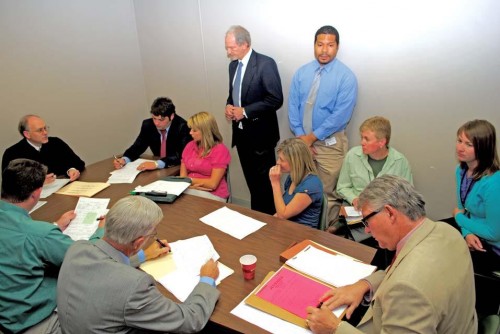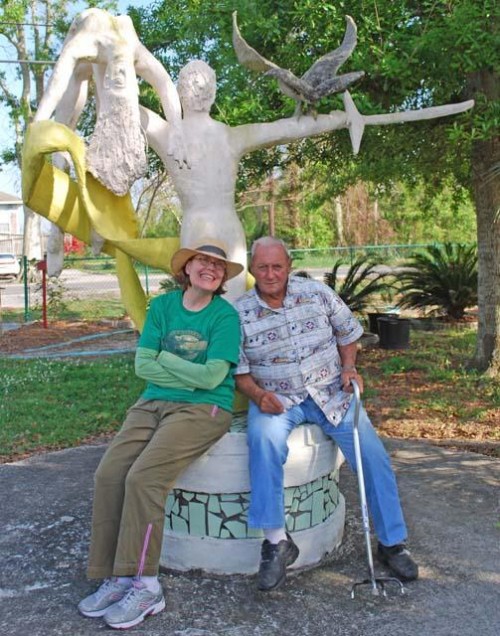
Drug treatment court a second chance for youth
April 2, 2009Rosalie "Rose" Billiot
April 6, 2009A journeyman bricklayer arrived in Chauvin over two decades ago with a burning desire to express his thoughts through art.
Within 10 years, Kenny Hill’s narrow property on Bayou Petite Caillou was altered into a world of personal redemption.
He created over 100 cement sculptures using everyday household items. The statues are immersed in Biblical symbolism and American history.
Today, Hill’s works comprise the Chauvin Sculpture Garden and are managed by Nicholls State University.
The collection is the centerpiece of the 2009 Chauvin Folk Art Festival, set for Sunday, April 19, at the Chauvin Sculpture Garden, 5337 Bayouside Drive.
The 50-member Friends of the Chauvin Sculpture Garden sponsors the bi-yearly festival, which began in 2005.
“We apply for grants to support the festival, and it takes two years to accumulate the funds,” said Dr. Gary LaFluer Jr., festival project manager. “We do this to promote awareness of Kenny Hill’s sculpture garden, support artists similar to Hill and to attract tourism to Chauvin.”
The Chauvin Folk Art Festival is organized independently from Nicholls’ Jubilee: A Festival of the Arts and Humanities, but it’s still part of the activities.
When Hill came to Chauvin in 1988, he pitched a tent as his home. Over time, he built a three-room house – living room and kitchen downstairs and an upstairs bedroom.
In 1990, he began work on his first sculpture, a man lifting a woman covered in yellow ribbon in his left hand, while holding a sword and an eagle with his right arm.
“He said, ‘If I don’t like it, I can throw it away,'” said Justin Neil, 76, who lived next door to Hill and still resides adjacent to the sculpture garden. “I guess he liked it.”
Hill’s second piece has become the most prominent: a 45-foot-tall lighthouse composed of 7,000 bricks. On the exterior, figures from American history, religious references and Hill himself protrude.
What may be most amazing about the volume of his work is that he only spent part of the year creating his sculptures.
“Come summertime, he moved to Branson, Mo., or Nashville, Tenn., to work on those big condominiums,” Neil said. “He would make top dollar working 14 hours a day, seven days a week. When it got too cold there, he came back down here, and it was still warm enough to do his statues.”
Despite a lack of training in art, Hill filled most of the property with over 100 beautifully crafted sculptures.
“They’re supported with rebar and welded underneath and covered in wire mesh,” said Rita Hermann, coordinator of the Chauvin Sculpture Garden and the Nicholls Art Studio, which is situated across the street. “Then the cement was mixed and he shaped it into form using really simple tools – fork, spoon and sponges to smooth the work.”
A fork was used to create strains in the hair. A spoon helped shaped the wings of the angels and eagles. When the cement dried, Hill used the sponge to draw out details like the clothing, the arms, down to the fingernails.
Neil describes his former neighbor as an all-around good guy.
“There was no fencing around the property back then. So we could stop by and talk with him, walk in and out,” Neil said. “My wife would cook dinner, and he would eat with us. Sometimes I would be cutting my grass with a push mower and he would say, ‘Mr. Neil, I’ll cut that for you.”
For Hill, the art was never about garnering fame or making money. He was adamant that the work was for his own enjoyment. He repeatedly denied requests for access to photograph or publicize his work.
“Several people have told stories that they asked him to make a sculpture for them, but he refused to do that for money,” LaFleur said. “He said his art was too personal to take money.”
By late 1999, Hill had stopped paying rent on the property and in early January 2000, his landlord evicted him.
Neighbors claimed by that time, Hill was deeply troubled and had abandoned his religion. He disappeared on foot, according to Hermann, but not before knocking the head off of a sculpture of Jesus.
Later that year, the Wisconsin-based Kohler Foundation, which specializes in preserving folk art, bought the property at the behest of former Nicholls Art Department Chair, Professor Dennis Siporski.
The foundation tore down Hill’s home, but it built an art studio across from the sculpture garden. In 2002, Kohler gifted the garden and studio to Nicholls for management.
Since then, a mythology has come to surround Hill, who has never returned. Neil said he spoke to Hill’s sister-in-law about seven or eight months ago. She said the one-time artist is living in Russellville, Ark., with her and his brother.
Today, visitors to the garden continue to search for the meaning of Hill’s cement sculptures. He never named any of his work. Neil said Hill told him the logic behind some of the pieces, but he’s since forgotten.
“If I knew it would turn out like this, I would have written them down,” he said. “A lot of them I forgot.”
Maybe it is best that we don’t know why these sculpture were created. The fact that they do exist and can be appreciated and interpreted for what they are should suffice.
“I’ve seen a lot of people come through here in my year and a half, and everyone feels encouraged to take away their own meaning from it,” Hermann said. “To me, that’s the beauty of the site. What Kenny Hill wanted instinctively happened. He gave this gift of art for anybody to walk in there and draw their meaning from it. That’s pretty amazing.”
The Chauvin Art Festival takes place from 11 a.m. to 5 p.m. The free event features live musical entertainment by Grammy-nominated artists Lost Bayou Ramblers, Treater and Mellowberry and Thibodaux belly dancing troupe Mehilka’s Mirage.
Local craftsmen will demonstrate pottery, metal work, traditional pirogue boat making, woodcarving and fishnet making. An art activity tent will introduce kids to Hill’s art by drawing some of their favorites pieces.
Food is provided by Sodexo.
For more information, contact Gary LaFleur at (985) 448-4715 or gary.lafleur@nicholls.edu.
Rita Hermann, coordinator of the Chauvin Sculpture Garden and Nicholls Art Studio, and artist Kenny Hill’s one-time neighbor, Justin Neil, share a moment near one of Hill’s many concrete works.









